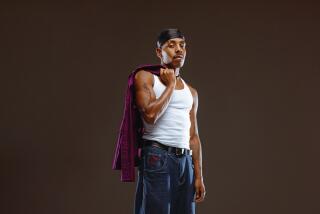Review: For Ezralow Dance, greatest hits from a lifetime in motion
Daniel Ezralow is a distinguished graduate of the Pilobolus generation: those contemporary dancers and choreographers who broke with tradition to form collectives, embrace popular culture and incorporate movement vocabularies from sports and other disciplines outside the dance world.
After declaring his creative independence in the early 1980s, Ezralow choreographed for numerous dance companies, Broadway, Hollywood, television, museums, the Oscars and the Olympics. Now, at age 60, he and his wife, Arabella Ezralow, have assembled favorite pieces in “Primo Passo,” a 35-year retrospective that arguably represents the modern dance equivalent of “Jerome Robbins’ Broadway” or “Fosse.”
At the Wallis Annenberg Center for the Performing Arts on Friday, his 13 dancers offered plenty of Ezra-highs along with a few Ezra-lows. Among the successes: two studies in choreographic evolution from 2004 that showed how complex, fast-moving dancing can develop from the simplest of origins. “SF” started with hopping in place, and “Pulse” began with sliding steps. Both became exciting ensemble showpieces.
Better still, the American premiere of “Awakening Solo” (2005) proved that a dancer simply stretching into the light could serve as a metaphor for the beginning of all kinds of life. Danced lyrically by Anthea Young, it showed Ezralow capable of understatement — not his usual style.
But nothing dug deeper than “Brothers,” a potent 1982 collaboration with David Parsons that used matched movement to powerfully depict a relationship. In the final phase of his career Rudolf Nureyev performed it locally with no great distinction, so it was rewarding to find Gerald Espinosa and Re Sean Pates making the most of its physical and emotional opportunities.
The lows on Friday included “Foreign Tails” (1986), a quartet that explored at excruciating length the movement possibilities of women in hoop skirts, with their partners serving less as lovers than furniture movers. Equally relentless in its own way, the sextet “Super Straight Is Coming Down” (1989) expanded from angry gesticulation to more assaultive gambits, with a series of embraces at the end causing sudden death. Before his encounter with fatal intimacy, Espinosa was able to cut loose in an impressive flailing solo, followed by the imposing Will Clayton, who quickly became the dominant force of the group.
The familiar “Chroma” (2013) belonged in a category by itself — initially charming as the dancers’ identities took shape through an exchange of apparel, but eventually tiresome in its energy-circus finale. Midway through, however, it grew terrific as an example of Ezralow’s innovative use of video technology. Here the dancers moved behind and between two projection screens, with the perfectly matched videos of them suddenly changing in unexpected ways so that the stage and video realities kept shifting, clashing or merging in a magical high-speed display of transformations.
A stunt? Perhaps, and likely to be horribly dated in another 35 years. But right now it opens up new vistas for onlookers and creative artists alike.
Recorded music accompanied everything except “Awakening Solo,” which featured Joachim Cooder playing his haunting score for mbira and nail violin at the side of the stage. Marc Rosenthal designed the video projections.
SIGN UP for the free Essential Arts & Culture newsletter »
Support coverage of the arts. Share this article.
YOU MIGHT ALSO LIKE:
Gustavo Dudamel gives Misty Copeland the royal treatment
Dance calendar: What’s coming up
Authenticity in casting: New rules are anything but black and white
More to Read
The biggest entertainment stories
Get our big stories about Hollywood, film, television, music, arts, culture and more right in your inbox as soon as they publish.
You may occasionally receive promotional content from the Los Angeles Times.










